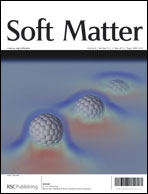Effect of covalent cross-links on the network structure of thermo-reversible ionic elastomers
Abstract
The effect of forming additional covalent cross-links on the thermo-reversible network structure of ionic elastomers was evaluated. Ionic elastomers are characterized by a strong physically cross-linked network resulting from a phase separation of ionic-rich nano-domains. The ionic domains are formed by the association of ionic groups that act as cross-links, promoting the elastic behaviour of these


 Please wait while we load your content...
Please wait while we load your content...